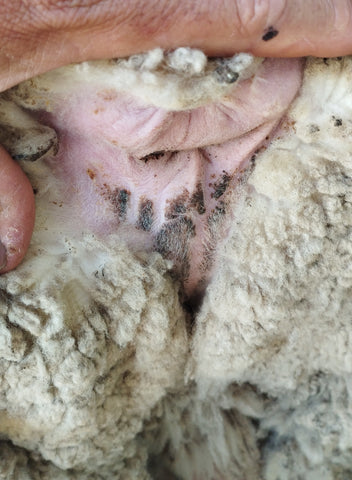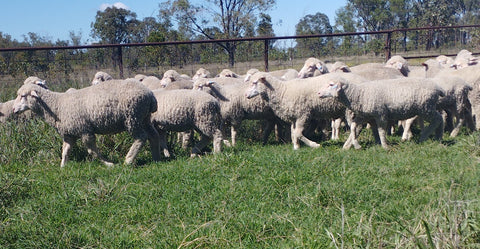"We cannot solve our problems with the same thinking we used when we created them." Albert Einstein.
With good rain about now, if you're needing some more rams give us a call or check them out online.
I hope you managed to get under plenty of that rain and your grass is getting away ahead of you. The change in the landscape is astonishing here!

Dopey calf got his head stuck... From bare dirt to lush green grass in a couple weeks.
As we head towards a new year and we start to think about classing sheep for the next joining season, I thought it would be helpful to discuss some Leader Sheep classing principles.
First, let's lay the foundation of why we even want to breed this style of sheep – non-mulesing, plain bodies with bold crimping, long and free growing wool. Why not continue to breed thick skinned "woolgrowers" or forget the wool entirely and go to a shedding breed?
Why even continue to grow wool?
- We love wool! Sometimes it's as simple as that. Wool is a wonderful natural fibre with many unique and superior characteristics. Plus, it is a beautiful fibre to look at and touch.
- Two enterprises in the one animal. The right type of merino produces both quality, fast growing lambs AND a valuable fleece, spreading market risk. The result is increased profitability with only a moderate increase in workload compared to a purely wool or purely lamb operation.
Now let's look at why you would want to breed this style of modern merino.
Animal Welfare (and market risk)
This is the obvious one. The reality is that the modern consumer is more environmentally and welfare conscious. As a result, hundreds of brands are backing away from mulesed products. There are over 200 brands that have committed to not using mulesed wool in their products, including big player brands such as Target, Big W, Myer, Adidas and Nike. (More than 220 brands and retailers back non-mulesed wool).
Australia is the only country in the world where mulesing is done, and it IS a stain on the perception of our product globally.
Plus, there's no getting around the fact that mulesing is a cruel process. We could get into the argument about using pain relief and mulesing being better than flystrike, and I would have to agree that mulesing is better than flystrike. However, that argument is very weak for two main reasons.
- Sheep that need mulesing still get flyblown even when mulesed.
- There is a better alternative. The problem can be fixed with breeding to a style of merino that has nearly no downside compared to a traditional mulesed merino, but plenty of upside.
Welfare is not just about flystrike though. Lamb deaths is also a major concern. Across the industry, well over 20% of lambs die in the first few days of their lives. Plain bodied, open-faced sheep have a better outlook on life and their lambs are much hardier at birth. Over 90% survival even in twin mobs is achievable when combined with good management.
This style of merino also just does better than traditional wrinkly merinos as they don't have that massive, energy hungry, thick skin to maintain. The lambs grow to maturity and fatten much quicker (MUCH quicker), ewes are in better condition with less feed, and they are significantly more fertile.
Fertility is so important as not only is it a major profit driver, but it also drives selection pressure as more animals can be culled each year.

Naturally bare and plain breech, while still having a YCFW of 28 and YFD of -1.5.
Workload
People always complain that the next generation won't put in the hard work and perhaps there is some truth in that. Either way though, why run a sheep that takes more work (i.e. more expense and less time to spend working on the business) if there is an alternative?
On our farm, it used to be that sheep were drenched and jetted routinely every 6 weeks. Just the other day I spoke to a farmhand on a large property running 10 000 sheep where they drench every THREE weeks! Talk about a never-ending job…
These days we only drench at weaning and maybe one other time in a high worm pressure year. Part of that is management with paddock rotations, but a large part is also the type of sheep we breed. We also never jet sheep. The only other treatments our sheep need is a bit of clik on the tail at marking and on the polls of rams to prevent flystrike from fighting wounds.
As our motto goes, we want sheep that work FOR us, not make work for us.

Weaning commercial lambs at just 12 weeks of age.
Genetics
Genetics may not quite be able to do everything, but I strongly believe that genetics can solve most problems. This is why selecting rams and classing sheep are two of the most important jobs on the farm. Selecting and working on your breeding plan can save you tons of time and money in the long run as well as making you more money. Define your goals and you will make amazing progress towards them.
I highly recommend the resources that neXtgen Agri have produced. Check out the "Ram Buying Guide" and "Your Genetic Plan" at neXtgen Agri Resources.
Here are a few things that Leader Sheep might use genetics for:
-Breeding worm resistant sheep instead of drench resistant worms.
-Breeding fly resistant sheep instead of chemical resistant flies.
-Breeding sheep with naturally plain bodies and bare breeches, while maintaining wool cut instead of cutting strips of skin off them.
-Breeding sheep that naturally lay down fat in good times instead of feeding them every time it turns a bit dry.
-Breeding sheep that perform at high stocking rates instead of having to run less sheep to keep the poor ones alive.
-Breeding sheep that birth and mother lambs well instead of checking the ewes every other day during lambing.
-Breeding sheep that give birth to TWO good lambs instead of only "one good lamb."
It can be done! It is very possible to breed all these traits into a sheep.
You might even have some of them already on your place! You just need to find them. We will start looking at that in January's article.
Until then, make the most of this Christmas season!
Merry Christmas from the team at Rissmerino🎄

https://xkcd.com/1706/

